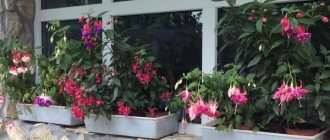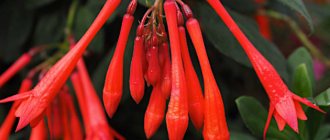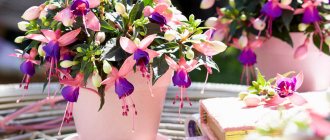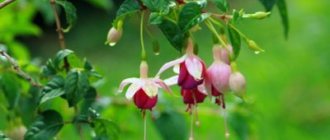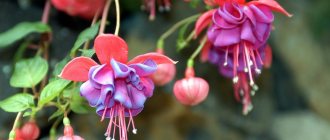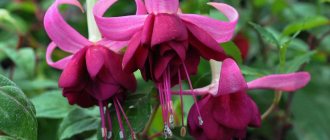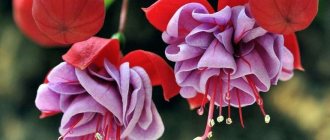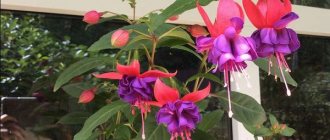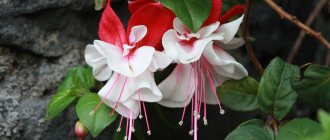- Not available
- Consultation: 8 922 1333 477
- Leave feedback
- Ask a Question
- Guarantees and return conditions
Semi-ampelous, vigorous, self-branching fuchsia with very large double flowers.
With large flowers, Bella Rosella is a unique fuchsia. Due to its strong growth, this large-flowered variety can be grown as a standard fuchsia; the branches and branches do not break. Bella Rosella is suitable for growing in hanging pots with a diameter of 25 cm+.
Long and abundant flowering. Elongated buds. The sepals are white with pink tips. The skirt, depending on the intensity of lighting, ranges from pink-reddish to purple in color. The leaves are medium green, convex, rounded. The shoots are strong and quickly become woody. Requires shading. The variety is sensitive to waterlogging.
All plants are grown using Osmokot long-acting fertilizer and on professional Klassman substrates
With large flowers, Bella Rosella is a unique fuchsia.
Fuchsia (Fúchsia) is a bright, perennial indoor plant that belongs to the fireweed family.
In 1695, Charles Prumier, a monk and botanist, first described the plant in his book Nova Planetarium Americanum Genera.
Already in 1703, fuchsia was cataloged, named after the physician and biologist Leonard Fuchs, whom Prumier admired.
Fuchsia propagation
If you want this perennial to produce many flowers every season, then you need to provide it with proper care. If such a need arises, planting material for propagation can also be obtained from it. There are many possibilities for this, since young plants can be obtained both from seeds and from cuttings and leaves.
Propagation by seeds
If you decide to get new fuchsia seedlings from seeds at home, keep in mind that this process will require a lot of time and effort. First of all, you need to stock up on quality seeds. To do this, you need to constantly monitor the condition of the mother plant, preventing its flower from self-pollinating. This can be done by carrying out the following activities:
- removing anthers from a recently opened flower;
- transfer of pollen from the paternal plant to the stigma;
- protecting flowers after pollination by covering them with a fabric or paper bag.
After a couple of weeks, the fruit reaches the maturity stage. After opening it, take out the seeds and let them dry for several days. For planting, use shallow containers filled with moist substrate. Seeds should be placed on the surface of the soil.
After sowing, the bowls with seeds must be transferred to a greenhouse, where optimal temperature and good lighting must be created. After 10-15 days, seed germination occurs. After another 1.5 months, the time comes to pick the seedlings. Subsequently, the young seedlings are hardened, for which they need to be taken out into fresh air for a while. The first time, hardening should be short - no more than 15 minutes, but later the residence time of the seedlings is increased. After another two months, the seedlings are transplanted into separate pots.
How to grow it correctly?
From seeds
If you decide to grow a flower from seeds, then you should take into account all the growing features:
- At the very first stages of formation, the seeds should be planted in a small box or cup with soil consisting of turf, peat and sand (in a ratio of 3: 2: 1). You should not use any fertilizers for the seeds at first; you can only treat the soil in which the seeds will be planted with a weakly concentrated solution of potassium permanganate.
- The seeds of this plant can be purchased at a flower shop, but you can also get them yourself; to do this, you need to select an already blooming fuchsia, select two flowers from it (paternal and maternal), then remove the anthers from them and perform pollination.
During the propagation process, pollinated flowers need to be covered with fabric bags. After about a month, the fruit obtained after pollination becomes ready; it must be dried and the seeds removed from it. March-April is the best time to sow seeds, either for your own or for store-bought ones. The seeds are simply poured into sifted peat in boxes or glasses, and then the dishes are placed in trays with water so that the soil is well saturated with moisture. Then the seeds are mixed with sand and sown in the ground. The container with seeds should be covered with film and left for 3-5 weeks. - Seeds covered with film must constantly be in humid conditions, so the soil must be soaked with water using a tray. Lighting should be moderately bright and diffused. The temperature should be maintained around +20C.
After the second leaves appear on the seedlings, they should be planted in separate plastic cups with holes in the bottom. Watering them should be moderate. Over time, when the plant becomes cramped in the glass, it will need to be transplanted into a larger pot.You need to be very careful with seedlings and you need to replant them, leaving the earthen clods intact.
- During the growth of fuchsia, it is necessary to constantly pinch it so that the plant is lush and its flowering looks much more graceful. When growing a flower from seeds, it must be provided with constant wintering. From the end of November, you need to lower the temperature of the fuchsia habitat to +5-10C. Also, the plant should be pruned before winter.
In the garden
Fuchsia cannot constantly grow in the garden due to winter frosts (with the exception of some hybrids), so during the winter the fuchsia will need to be replanted in a pot and moved to some room; this should be taken into account when planting the plant in the garden. We wrote more about the wintering features of fuchsia here.
Growing fuchsia in the garden is quite difficult, so you need to take into account factors and features, such as:
- This plant is unpretentious to the soil, but still, fuchsia prefers light soil with neutral acidity. The soil should be fertile and well moistened. You can fertilize adult plants with both complex chemical fertilizers and natural compost or humus.
- When growing in the garden, preference should be given to proven store-bought seeds.
Sowing seeds should be done in March in order to plant the plant in the garden in May. To germinate seeds, it is advisable to use transparent, spacious plastic containers. At the very beginning, the soil must be sprinkled with a weak solution of potassium permanganate, and in the future it must be constantly kept moist. This container with soil and seeds should be covered with film and kept at a temperature of about +20C. - To form a flower into a bush, you need to prune and pinch the fuchsia, as this will help its growth. Pinching the plant is carried out in 3 stages, each of which takes about a month. At each stage, the upper part of each of the branches is removed; this is necessary so that the plant grows wider and the number of flowers doubles. Pruning is carried out mainly for indoor fuchsias, it occurs in two stages - autumn and spring. In autumn, those parts that had flower stalks are cut off from the plant. In spring, all frail and dry parts of the flower are completely removed.
Varieties with photos and names
Fuchsia is an ancient plant. Has more than 1000 different types. Let's look at the main and most common varieties below.
Three-leaved (Fuchsia triphylla)
Fuchsia triphylla is a bush plant. It looks amazing in the garden in a hanging basket, because it grows in width and does not exceed 60 centimeters in length. The leaves have an oval shape.
Their peculiarity is that the upper side of the leaf flows from green to red, and the lower side has a brownish-red tint. The flowers of this fuchsia variety resemble the shape of a bell and are often fiery red in color. Abundant flowering from May to October.
It is allowed to keep the plant at high temperatures and open sun, and in winter you should not leave the plant at temperatures below 10 degrees C. The most common varieties include Thalia, Mantilla, Coralle, Elfriede Ott and others. Grown to create a landscape for a suburban area.
Thalia
Thalia is a plant adapted for growing not only in standing reservoirs, swamps, lakes, ponds, but also in wetlands. To grow this variety, the main thing is sunlight. Can reach up to 2 meters in length. The leaves are characterized by a whitish coating, have an oval shape and a length of no more than 20 cm. The first leaves appear 10-14 days after planting. A fairly hardy plant, because it can withstand temperatures down to -18 degrees C.
Reproduction
The practical actions of many gardeners have proven that the simplest and most effective way to propagate fuchsia is to root cuttings. The latter are obtained by pruning bushes after wintering; accordingly, the propagation process should begin in early March.
There are 3 options in total:
- cuttings;
- leaves;
- seeds.
Cuttings
The cuttings obtained after pruning must be rooted. The best nutrient medium is plain water, but some varieties feel better in soil mixed with sand, peat and a universal mixture.
Next, observation is carried out for 10-15 days. If the shoot has sprouted new roots, it is necessary to continue observation for another 5-7 days, after which the flower is transplanted into a pot.
The diameter of the pot should not exceed 10 cm, otherwise the plant will spend too much effort on forming the root system, which will cause the leaves and buds to be deprived of nutrients.
After a year, the flower can be transplanted into a pot with a diameter of 15-20 cm, and buds can be expected the next season.
Leaves
This option is more labor-intensive and time-consuming. It is necessary to choose a medium or large size sheet with a long stem. The latter is planted in soil consisting of a universal mixture and sand, and is abundantly filled with water. For 1-2 months, the leaf must be sprayed with warm water to maintain optimal conditions. Shoots should appear at the cut site. If this happens, it is worth reducing the number of sprays per day, and subsequently abandoning them completely. Further, the technology is no different from cuttings.
Seeds
The most long-term and complex type of reproduction, which requires the presence of another flower for pollination. The resulting seed is buried in the ground at a depth of 3-5 mm. The first shoots should appear in two to three weeks, all this time it is necessary to spray the ground with warm water. Next, actions similar to breeding using cuttings are carried out.
Landing instructions
The easiest way to grow is to plant fuchsia in a pot or hanging basket that will hang on the veranda. This type of planting is not so problematic, because when frost sets in, the flower can simply be brought into the house and not be replanted again. For experienced gardeners, it will not be difficult to plant a plant in a flowerbed, but in this case you need to think carefully about the planting location.
Fertilizer
It does not matter where in the garden the flower will be located in a basket or in a flower bed, the composition of the soil and fertilizer is of great importance. Before planting, it is necessary to add a sufficient amount of humus and phosphorus fertilizers.
During flowering, you should also not forget about fertilizer, as the flowers will quickly wither. Each plant needs to be fertilized from the moment of planting.
For fuchsia, the type of fertilizer can be distributed according to growth phases:
- Young plants need a complex fertilizer that contains a large amount of nitrogen. This component of the fertilizer helps to accelerate the growth of the plant and its greening.
- For a grown flower, fertilizers with a high content of potassium and phosphorus are best suited, which will help the plant produce a large number of buds for flowering.
A good option for fertilizer would be to alternate mineral with organic. It should be remembered that high-quality fertilizers increase the decorative properties of the plant.
You should not fertilize the plant for 2-3 weeks after replanting (you can find out how to properly replant fuchsia and get abundant flowering here).
Reproduction
This plant has several methods of reproduction, including:
- Seed propagation: in order to obtain seed fuchsia, gardeners resort to artificial pollination. Gardeners like this type of propagation, because by mixing several different varieties of plants you can get a completely new one that is different from the rest. Seeds must be collected in dry and warm weather, and after collection the material must be dried.
- Using cuttings: propagation in this way must be done in March. Cuttings from 5 centimeters long are suitable for this. Usually they are first placed in water for rooting, after which three weeks later they are planted in a pot consisting of fertilizers and sand.
- Using leaves: this method is one of the longest. For this species, select stems with several leaves and carefully tear them off from the plant, after which, without sprouting the roots, place them in loose soil 1 centimeter deep and cover with a lid. A plastic or glass lid is best. For successful germination, the leaves must be watered daily by spraying with boiled water. The plant will be ready for transplanting immediately after the roots appear.
Each type of germination is interesting in its own way, but the most common is growing using cuttings. This method is most effective for use by inexperienced gardeners.
Material for seed germination is obtained exclusively from ripened flowers.
Some nuances
It is possible to grow fuchsia in the garden, but to do this you need to spend time and be prepared for the fact that the plant does not take root. In order for the plant to take root in the flowerbed, you should remember the following rules:
- For planting, a plant is used that has already been growing in a pot for some time. You should not use recently sprouted flowers; they may not take root in the new soil.
- The planting site should be chosen carefully, without direct sunlight or drafts.
- No other flowers should grow near the chosen location, otherwise one of the plants may die.
- Fuchsia should only be planted in pre-fertilized soil and remember to feed it when the flowers are releasing.
Using these simple rules when planting a plant, you can achieve good results. Then the plant will grow and produce many new buds, delighting the gardener.
Signs and superstitions
There is a very beautiful legend about this flower. It says that in the distant past there lived 7 sisters. They were very beautiful and distinguished by their dancing skills. When they danced, nature froze. A magician from another state heard about them. He decided to take one of the girls as his wife and the rest as concubines. The sisters refused. Out of anger, the magician turned them into an unusually beautiful flower, reminiscent of their dance.
There is a sign that says that when moving, you should take a fuchsia plant with you, because it will create an aura, harmony of the home, strengthen relationships between residents and protect against quarrels. It is recommended to place the plant in a place where you often gather as a family. This could be the living room or kitchen.
The most common superstition is that fuchsia is the widow's flower or "widow's tears." However, the origin of such a superstition is unknown and many girls consider fuchsia to be one of the most magnificent flowers in its beauty. There is a legend that fuchsia brings wealth and income, and also promotes the development of intuition. Therefore, it is recommended for businessmen to keep the plant in their office.
Growing conditions
Among indoor and garden flowers, fuchsia is far from the most demanding plant. It can be grown in a pot, the volume and size of which will allow it to be used both in the garden and in the room.
Lighting
Fuchsia loves the sun, but grows in slightly shaded conditions. If you leave a flower on a south-facing balcony, the flowers and leaves may get burned. The same thing can happen on a south window in an apartment.
In autumn and winter, when there is little sunlight, this plant also needs lighting. Every day the flower should receive light for 12 hours.
The soil
Any soil with good drainage will be suitable for perennials. Perlite, vermiculite or expanded clay are used as drainage. You can make a fertile soil composition yourself by using humus, peat and sand in proportions of 3: 2: 1.
For good growth and development of fuchsia, you need loose and nutritious soil mixtures that are able to absorb water and perform air exchange. The soil reaction should be slightly acidic or neutral. If a plant is planted in soil that is poor in nutrient components, and even with a pronounced alkaline reaction, the perennial will very quickly begin to rot, the color of its foliage will lose brightness, flowering will be sparse, or the plant will completely shed its buds.
If it is not possible to prepare the soil substrate yourself, you can purchase it ready-made by visiting a specialized store.
Fertilizers
To make fuchsia grow intensively and bloom profusely, the plant needs to be fed. But you can apply fertilizer only 1 month after you have completed the annual spring flower transplant. The frequency of feeding is once a week. Use ready-made mineral compositions for flowering plants. During the period when you are growing a seedling or forming a standard tree, fuchsia must be supplied with nitrogen compounds.
Some drugs, for example, "Epin", are not applied to the ground; they need to be sprayed on the plant to enhance its growth and acclimatization. Fuchsia is fertilized with bone meal powder, which is distributed over the surface of the soil, and then watered. It is enough to add 1 tbsp. l. funds for a pot with a medium-sized plant.
Excessive feeding is harmful to the plant. An excess of minerals will force the perennial to grow foliage, but it will bloom poorly - the flower stalks will be weak and few of them will be formed. Fertilize should be done in spring and summer, and in autumn and winter you need to give the flower a rest.
Most common varieties
Many modern varieties are characterized by bright color combinations.
Fuchsia Blue Vale
This is a universal variety; it can be grown either as a bush or as an ampel. The snow-white sepals of double, large flowers have a green tint along the edge. The flower's skirt is fluffy and lavender in color.
Flowering is long lasting and very abundant.
Fuchsia Bella Rosella
The plant has some of the largest flowers (10-12 cm). They are terry, bright, lilac-pink with snow-white stamens and pale pink sepals. Flowering is abundant and long lasting.
Fuchsia variety Bella Rosella has an ampelous and bush form. It is unpretentious and can grow in shade.
Variety Bella Rosella
Fuchsia Blue Angel
Blue Angel variety is an exquisite, memorable fuchsia. The flower size is up to 12 cm in diameter. The corolla (skirt) of the flower is double dark lilac in color, the sepals are white. When fully bloomed, white stamens with pink anthers become a spectacular accent. The bush is semi-ampelous (drooping).
Fuchsia Hollis Beauty
The flowers are large (7-8 cm), double, white sepals, lilac-blue skirt. The bush grows very neatly, has a compact shape, and branches well. The variety tolerates heat and bright sun better than other fuchsias.
The flower is elegant, contrasting, white-green sepals set off the purple-pink skirt. Especially good in full dissolution. Pink elongated stamens set off milky white anthers.
Important! The growing form is ampelous, the lashes of an adult plant grow up to 60 cm in length
Fuchsia Blue Ice
The plant was obtained as a result of the starting mutation of the Dark Eyes variety in 1954 in the United States of America. Large, double flowers are distinguished by a characteristic arrangement of petals. They resemble a multi-layered petticoat. The color of the petals is deep lavender, the sepals are light crimson. It is interesting that in plants of this variety, flower petals can vary in color intensity. The variety is undemanding; it is grown in bush and hanging forms. Grows quickly, restrictive pruning is recommended to form a dense crown. Feels good in partial shade.
Fuchsia Bicentennial
Fuchsia ampelous Bicentennial is painted in salmon-orange tones. The characteristic magenta strokes along the edge of the multi-layered skirt create an extraordinary color contrast. The flowers are elongated, rather large, in the form of buds. Light sepals become bright orange over time.
The variety was bred by Californian gardener Ted Pasquesen in 1976 and dedicated to the 200th anniversary of US independence. Paskesen carried out lengthy breeding work to obtain a variety that was resistant to heat and strong winds.
The plant forms a dense, branching crown and blooms profusely.
Variety Blue Mirage
Fuchsia Blue Mirage
The plant can be grown as a semi-mounted plant, in the form of a drooping bush and in hanging containers.
Blue Mirage is a large-flowered variety that blooms with deep purple flowers with snow-white sepals. The length of the shoots of the variety is up to 40 cm. Flowering is early, abundant, and long-lasting. The flowers are double and large.
The leaves are medium in size, the stems become woody quickly, so the variety is easy to grow in standard form. The variety is fast growing and winters well. Suitable for growing by beginning gardeners.
Fuchsia Cecile
The flowers are large, double, and have a bright, unusual combination of shades. The wavy, layered petals are lavender blue and the sepals are dark pink. Fuchsia variety Cecile is grown in bush and hanging form.
Vessel
The unique purple-pink color has become the hallmark of the flower; it is not without reason that one of the first synthetic dyes, fuchsin, received its name.
The ships of the Japanese company ONE (Ocean Network Express), which is engaged in sea container transportation, cannot be confused with others. Their signature color is fuchsia.
Photo 7 Motor ship "Fuchsia"
The no less “glamorous” pleasure catamaran “Fuchsia” plies along the Moscow River.
Caring for fuchsia is easy. If you create optimal conditions for the plant, elegant lantern flowers will create a bright mood for many years.
Video
Also watch the video about the varieties of this bright and beautiful plant.
We recommend reading other articles about indoor plants, such as: Ginura, Syngonium, Roicissus, Pellionia.
Subscribe to email notification of admission:
Bella Rosella variety is ampelous. The flowers are gigantic, showy, neon pink. The sepals are white, their tips are watercolor-painted with a delicate light green color. Despite its size, this fuchsia produces quite a lot of buds.
The price is for a rooted cutting with a developed root system (see photo).
Care
Breeding roses from cuttings at home
After the petioles have been planted and greenhouse conditions have been created for them, they must be ventilated every day (1-2 times). Moisten the soil periodically, preventing the earthen ball from drying out.
When the plant gets stronger, it is transplanted into a larger pot (preferably ceramic, this will protect the crop from overheating in the summer).
Fuchsia in a pot
Plants are fed with potassium-phosphorus substances during the flowering period. As necessary, they pick off dried flowers, form a crown, loosen the soil, and spray the bush. Fuchsia is replanted in the spring.
Watering
In terms of care, fuchsia is not picky. It is very easy to care for her. As for watering, do it as the top layer of soil dries. In winter, moisture should be moderate. Use only settled water at room temperature. It is much healthier and softer. At the end of the growing season, reduce watering. For the period October-November, moisturizing should be completely stopped. At lower temperatures, reduce watering fuchsia to 1-2 times a month.
During plant growth, it is useful to spray it with a spray bottle. Do this morning and evening. To humidify the air, place a small cup with pebbles filled with water near the container with the flower. In autumn and spring, excess moisture is not recommended, so stop spraying.
We talked in detail about caring for fuchsia at home and other important aspects of growing a flower in our article.
Fuchsia transplant
Fuchsia needs annual replanting, which is carried out in the spring. The substrate used is a mixture of turf, leaf soil, peat, sand and humus in equal parts. A drainage layer, for example, made of expanded clay, is required. It is best to replant fuchsia using the transfer method: pour a little soil mixture into the pot on the drainage layer, then transfer the plant there along with a lump of earth, then fill the voids with the soil mixture. The transplanted fuchsia is placed in a well-lit place, the stems are cut to one third of the length, sprayed and watered well. If you do everything right, fuchsia will bloom profusely.
Fuchsia fertilizer
Fuchsias growing in open ground are best fed with biological fertilizers. Fuchsia at home responds well to fertilizing with ready-made complex fertilizers for flowering plants, which are applied once every two weeks during the growing season. These fertilizers, as a rule, do not have a nitrogen component or it is very insignificant. In the winter months, a dormant period begins, and the plant will not need feeding.
Pruning home fuchsia
Experts suggest pruning indoor fuchsia twice a year: at the end of the growing season - in early October, and in winter - at the very beginning of January. The first pruning involves removing all faded branches at a height of 2 cm from the dormant buds located in the axils, which are easy to detect by carefully examining each branch. After pruning, you can begin removing pests, seed pods you don't want, and spent flower stalks. The second pruning is carried out in January and represents the final formation of the plant crown.
Pinching the cuttings
A young plant is usually pinched three times, each time removing the growing points of new shoots. The first time, pinch out one existing shoot. The second time - the growth points of two newly formed cuttings are pinched again (there are already two of them). And the third time, having cut off all the growing points, they get a fairly fluffy bush with many shoots formed.
Subtleties of caring for ampelous fuchsia
Ampelous fuchsia is one of the most unpretentious indoor plants. Caring for a flower consists of following standard rules of agricultural technology - watering, fertilizing, pruning and proper wintering.
Basic rules of care:
- Fuchsia needs regular and moderate watering. The soil in the flower pot should remain moist, but not wet. On hot days, you can additionally spray the foliage with a spray bottle. In winter, the amount of watering is reduced to once every 2-3 weeks.
- Ampelous fuchsia is prone to strong branching, creating increased stress on the root system. Therefore, excess growing shoots must be trimmed in a timely manner. If the plant begins to bloom weakly, the sprouts begin to dry out, and the shoots begin to break under the weight of the peduncles, it is necessary to prune.
- For abundant flowering of ampelous fuchsia, it needs nutrients, which it can get from fertilizers. It is best to use complex mineral fertilizers for ornamental crops. Fertilizing needs to be done every 8-10 days.
- Ampelous fuchsia, grown in the garden, on the terrace or porch, is transferred into the house before the onset of the first autumn frosts. The tropical plant does not tolerate cold, so it will quickly die.
Ampelous fuchsia is a spectacular and colorful indoor plant that is loved by many gardeners. It can be grown in flowerpots, decorating the interior of a room, on a balcony or terrace. For lush flowering and health, fuchsia requires minimal care, thanks to which it will delight with lush and bright inflorescences.
